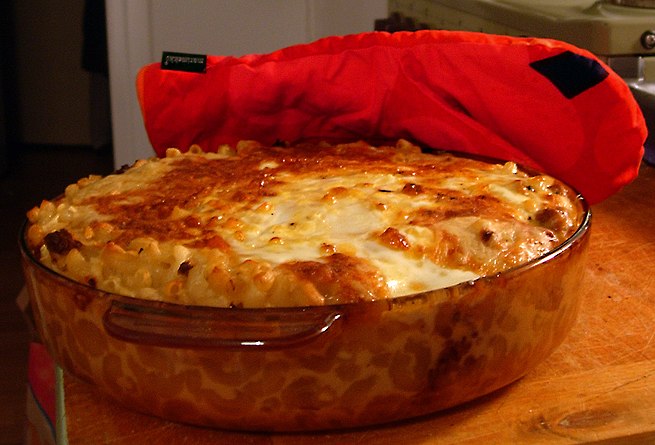
Main Difference
The main difference between Casserole and Stew is that the Casserole is a type of food and Stew is a combination of solid food ingredients that have been cooked in liquid and served in the resultant gravy
-
Casserole
A casserole (French: diminutive of casse, from Provençal cassa ‘pan’) is a large, deep pan used both in the oven and as a serving vessel. The word is also used for the food cooked and served in such a vessel, and, if so, the cookware itself is called a “casserole dish” or “casserole pan”. “Casserole” should not be confused with the word cacerola, which is Spanish for “cooking pot”.
In the United States and continental Europe, casseroles usually consist of: pieces of meat (such as chicken or ground meat) or fish (such as tuna), various chopped vegetables, a starchy binder (such as flour, rice, potato or pasta), and often a crunchy or cheesy topping. Liquids are released from the meat and vegetables during cooking, and further liquid in the form of stock, wine, beer (for example lapin à la Gueuze), gin, cider, vegetable juice, or even water may be added when the dish is assembled. Casseroles are usually cooked slowly in the oven, often uncovered. They may be served as a main course or side dish, and, conveniently, may be served in the vessel in which they were cooked.
In the United Kingdom, the Republic of Ireland, Australia, and New Zealand, a casserole is named after its dish, rather than its contents; casseroles in these countries are very similar to stews. The difference is that once the meat and vegetables are browned on top of the stove, they are then cooked in liquid in a closed dish in the oven, producing meat that is tender and juicy, from long, slow cooking. The heat is indirect, so there is less chance of burning than on the stove.
Examples of casserole include: ragout (French), Lancashire hotpot (English), cassoulet (French), moussaka (Greek), shepherd’s pie (UK), timballo (Italian), sweet potato pie (southern US), and carbonnade (Belgian). As previously noted, a distinction can be made between casseroles and stews: stewing is a cooking process whereby heat is applied to the bottom of the cooking vessel (typically over a fire or on a stove), whereas casserole is generally baked in an oven, where heat circulates all around the cooking vessel. Similarly compared, casseroles may be cooked covered or uncovered, while braises are typically covered to prevent evaporation.
-
Stew
A stew is a combination of solid food ingredients that have been cooked in liquid and served in the resultant gravy. Ingredients in a stew can include any combination of vegetables (such as carrots, potatoes, onions, beans, peppers, mushrooms, and tomatoes) and may include meat, especially tougher meats suitable for slow-cooking, such as beef. Poultry, sausages, and seafood are also used. While water can be used as the stew-cooking liquid, stock is also common. Seasoning and flavourings may also be added. Stews are typically cooked at a relatively low temperature (simmered, not boiled), allowing flavours to mingle.
Stewing is suitable for the least tender cuts of meat that become tender and juicy with the slow moist heat method. This makes it popular in low-cost cooking. Cuts having a certain amount of marbling and gelatinous connective tissue give moist, juicy stews, while lean meat may easily become dry.
Stews are thickened by reduction or with flour, either by coating pieces of meat with flour before searing, or by using a roux or beurre manié, a dough consisting of equal parts of fat and flour. Thickeners like cornstarch or arrowroot may also be used.
Stews are similar to soups, and in some cases there may not be a clear distinction between the two. Generally, stews have less liquid than soups, are much thicker and require longer cooking over low heat. While soups are almost always served in a bowl, stews may be thick enough to be served on a plate with the gravy as a sauce over the solid ingredients.
-
Casserole (noun)
A dish of glass or earthenware, with a lid, in which food is baked and sometimes served.
-
Casserole (noun)
Food, such as a stew, cooked in such a dish.
-
Casserole (verb)
To cook like, or as, a casserole; to stew.
-
Stew (noun)
A cooking-dish used for boiling; a cauldron. 14th-17thc.
-
Stew (noun)
A heated bath-room or steam-room; also, a hot bath. from 14thc.
-
Stew (noun)
A brothel. from 14thc.
-
Stew (noun)
A prostitute.
-
Stew (noun)
A dish cooked by stewing. from 18thc.
-
Stew (noun)
A pool in which fish are kept in preparation for eating; a stew pond.
-
Stew (noun)
An artificial bed of oysters.
-
Stew (noun)
A state of agitated excitement, worry, and/or confusion.
“to be in a stew”
-
Stew (noun)
A steward or stewardess on an airplane.
-
Stew (verb)
To cook (food) by slowly boiling or simmering.
“I’m going to stew some meat for the casserole.”
“The meat is stewing nicely.”
-
Stew (verb)
To brew (tea) for too long, so that the flavour becomes too strong.
-
Stew (verb)
To suffer under uncomfortably hot conditions.
-
Stew (verb)
To be in a state of elevated anxiety or anger.
